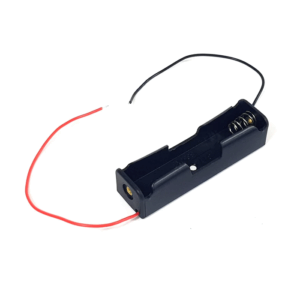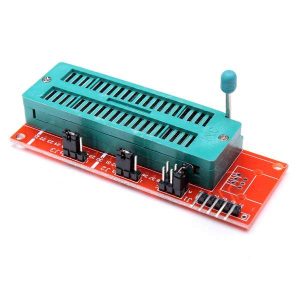Multilink Overview
Multilink debug probes allow a PC access to the Background Debug Mode (BDM) or JTAG interface on wide range of ARM Cortex and 8-16-/32-bit devices, in order to halt normal processor execution and use the PC to control the processor. The user can then directly control the target’s execution, read/write registers and memory values, debug code on the processor, and program internal or external FLASH memory devices.
Supported manufacturers include NXP, STMicroelectronics, Cypress, Infineon, Silicon Labs, and many others. Multilink connects between a USB port on a Windows machine and the standard debug connector on the target. Microcontrollers are supported via the multiple headers located under a flip lid on the Multilink case. Ribbon cables suitable for a variety of architectures are included.
Please note: Multilink debug probes do not include software, as there are myriad options regarding the device architecture and utility of software that the user might require. Users most often purchase a version of PEmicro’s PROG programming software that is compatible with their device architecture. ICD debugger software and PKG software packages are available as well. Users can also create custom solutions with UNIT library routines. There is support for Multilink in many NXP and other third party tools, such as MCUXpresso, or STMicroelectronics’ STM32CubeIDE. Click for a listing of compatible 3rd party ARM-based IDEs. In addition, ARM-based Eclipse IDEs are compatible, with the appropriate GDB Server plug in.
Multilink Models & Features
Models
There are 3 models of Multilink:
MULTILINK ACP MULTILINK UNIVERSAL MULTILINK UNIVERSAL FX
Standard Features
All Multilink debug probes offer these standard features:
- USB interface from PC to Multilink allows for fast, easy programming and debugging — with the ease and compatibility of the USB interface.
- Draws power from USB interface– no separate power supply required (draws less than 1mA from the target).
- Works with target voltage: 1.8V-5.25V
- Supports JTAG daisy chaining of multiple ARM MCUs
- ARM device support includes both the JTAG and SWD protocols
- Includes USB cable, Type A Male to Type B Male, 6-ft.
“Universal” Features
MULTILINK UNIVERSAL and MULTILINK UNIVERSAL FX also include these features:
- Pipelined programming algorithms for some Power Architecture families that dramatically increase programming speed.
- Auto-frequency detection + trimming capabilities for HCS08 devices
- Auto-frequency detection for HC(S)12(X) devices.
- Generates programming voltage on RESET line for RS08 devices.
- Target Frequency: 16Khz-50Mhz (applies to HCS08, RS08, CFV1, S12Z, or HCS12X only)
Advanced Features
MULTILINK UNIVERSAL FX supports these additional advanced features:
- High-speed USB interface from PC to Multilink allows for fast, easy programming and debugging — up to 10X faster than the other Multilink models.
- Can be used to power target MCU:
- Target Voltage: 3.3V, 5.0V
- I/O line clamping for added protection
Multilink Universal FX Performance Note
The exceptional performance increases seen with the USB Multilink Universal FX are limited to synchronous architectures: ARM devices, Kinetis, S32, MPC55xx-577xx (& STMicroelectronics SPC5), Coldfire V2-V4, DSC, MPC5xx/8xx, and HC16/683xx.

No-Cost Software Features
1) PEmicro’s UNITACMP Library SDK for ARM Cortex-M processors is free to download. This allows the user to create an application which can fully control the execution of an embedded processor via Multilink debug probes or Cyclone programmers.
2) PEmicro’s no-cost GDB Server for ARM devices (Eclipse plug-in) includes the following powerful features:
- Real-Time Expression View
This view gives the user the ability to view variables and memory while a target ARM device is running. Sometimes the process of halting the target masks a bug. Sometimes, in order to reproduce a particular bug, the program must be kept running while being fed a particular set of data. In those cases, having the ability to view variable values as they change without halting the target is a great asset. - OS-Aware Feature Supports FreeRTOS
The GDB server will automatically detect the presence, type, and configuration of an OS by querying the application’s symbol table for identifying characteristics. Using these discovered symbols, the debugger can traverse the kernel’s internal data structures to enumerate the available threads and their corresponding execution context. This information is then used to dynamically populate the Eclipse views as the user navigates between the threads. Additional OS support is expected to be added soon. - Single-Wire Output (SWO) Debug Tools
By using NXP’s MCUXpresso or PEmicro’s plug-in for ARM-based GDB IDEs, users can measure power consumption of their device in real time (FX only), monitor multiple variables and expressions in real time, use printf calls to be notified when specific events occur during the debug session, and use trace capture to log user-specified events and triggers. This allows much more insight into the operation of the user’s code.
| System Requirements |
| Windows 7/8/10: 32-bit (x86) or 64-bit (x64) Windows 11: 64-bit (x64) with USB 2.0 software support. Requires a USB port on the PC. |
| Multilink FX | |
| Supported Devices | · ARM Cortex-M · Many additional 8-/16-/32-bit devices |
| Communications | · High-Speed USB 2.0 |
| Speed | · Very Fast |
| Power Management | · Can provide 3.3V/5V via ribbon cable |
| SWO Features | · Real-Time Power Measurement · SWO ITM Console · SWO Data · Real-Time Expressions |
| PROG Software Included? | · No |
| Stand-Alone Programming | · No |
| On-Board Storage | · No |
| Automation | · Scripted programming with CPROG (sold separately) |
| Security Features | · No |
| Expanded Storage | · No |
| Documentation / Manuals | |
| Multilink Universal/Universal FX Tech Summary (553 KB) Usage and other instructions for USB Multilink Universal & USB Multilink Universal FX. Document version 1.18c, updated Oct. 2022. | |
| Hardware License Activation Guide (386 KB) PEmicro software with -HL- in the part number has a hardware license that must be installed into a hardware interface, typically a Multilink. This is a guide to assist with that installation. | |
| Multilink FX Fact Sheet (972 KB) Fact sheet with brief description of Multilink FX usage and features. | |










Reviews
There are no reviews yet.